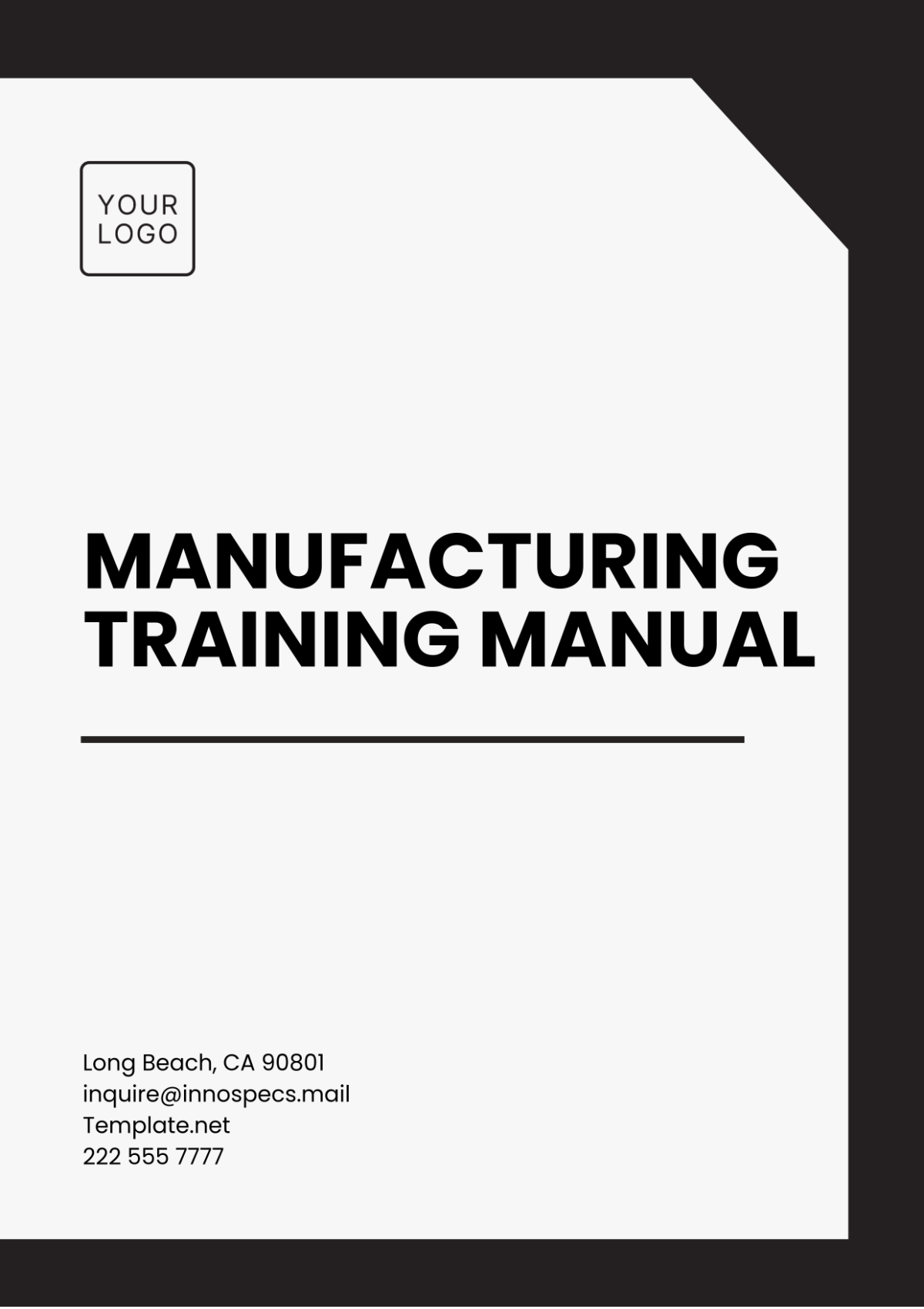Free Manufacturing Training Manual

Prepared by: [Your Company Name]
Date: [Date]
I. Introduction
This training manual is designed to educate employees on the metal fabrication processes in our manufacturing facility. It encompasses all essential procedures, from raw material handling to final product assembly, ensuring each worker understands the role and standards required. By following this manual, employees will contribute to our commitment to quality and safety, enhancing our productivity and work environment.
II. Company Policies
Our company is committed to maintaining a safe and efficient manufacturing environment. Adherence to the following policies is mandatory:
Attendance and Punctuality: Regular attendance is essential for maintaining production schedules. Employees must notify their supervisor at least one hour before their shift if they are unable to report to work.
Personal Protective Equipment (PPE): All employees must wear appropriate PPE while on the factory floor. This includes safety goggles, gloves, hard hats, and steel-toed boots. Failure to comply will result in disciplinary action.
Confidentiality: Confidentiality of company processes and client information must be maintained at all times. Employees are prohibited from discussing sensitive information outside the workplace or with unauthorized personnel.
Professional Conduct: Respectful behavior towards colleagues and supervisors is expected at all times. Harassment or discrimination of any form will not be tolerated and will lead to immediate investigation and potential termination.
III. Safety Procedures
The safety of our employees is of utmost importance. Please familiarize yourself with the following safety procedures:
Pre-Shift Safety Check: Conduct a safety check before the start of each shift to ensure all equipment is functioning properly. Complete the safety checklist and submit it to your supervisor.
Reporting Hazards: Report any hazards or unsafe conditions immediately to the supervisor. This includes equipment malfunctions, spills, or any situation that may compromise safety.
Emergency Procedures: In case of an emergency, follow the evacuation plan posted in designated areas. Participate in regular emergency drills to familiarize yourself with evacuation routes and procedures.
First Aid: Familiarize yourself with the location of first aid kits and emergency contact numbers. First aid training will be provided as part of the onboarding process.
IV. Standard Operating Procedures (SOPs)
Each manufacturing process has its own SOP to ensure consistency and quality. The following are key procedures:
Material Handling and Storage:
Properly label all materials and store them in designated areas to prevent cross-contamination.
Use appropriate lifting techniques or mechanical aids to avoid injuries when handling heavy materials.
Cutting and Shaping Metals:
Follow precise measurements as per blueprints to ensure accuracy.
Always keep hands and tools clear of cutting blades and ensure guards are in place.
Welding Techniques and Safety Measures:
Only trained personnel are authorized to operate welding equipment.
Use fire-resistant curtains and shields to protect nearby workers from sparks and UV radiation.
Final Assembly and Inspection:
Follow assembly instructions closely to prevent errors and ensure product integrity.
Conduct a thorough inspection of the finished product against quality standards and report any discrepancies.
V. Equipment Operation
Each employee must be trained and authorized before operating any equipment. Common equipment and their operation guidelines include:
Equipment | Operation Guidelines |
|---|---|
Laser Cutter |
|
Hydraulic Press |
|
CNC Machine |
|
Angle Grinder |
|
VI. Quality Control Standards
Maintaining quality is vital. Employees should strive to meet the following standards:
Inspection Checklist: All products must pass the inspection checklist before being approved for shipment. This checklist includes criteria for dimensions, weight, and finish quality.
Measurement Verification: Regularly verify measurements against blueprints and specifications. Use calibrated measuring tools to ensure accuracy.
Deviation Reporting: Document and report any deviations from quality standards immediately. A corrective action plan must be created and approved by the quality assurance team.
Feedback Loop: Engage in regular meetings to discuss quality issues and solutions. Continuous improvement is a team effort, and all feedback is valued.
VII. Training and Assessment
Continuous learning and skill assessment are key to our success. Training includes:
Initial Orientation: All new hires will participate in a comprehensive orientation program covering company policies, safety procedures, and basic equipment operation.
Ongoing Workshops: Regular workshops on updated techniques and procedures will be held quarterly. Employees are encouraged to participate actively and share their experiences.
Performance Evaluations: Performance evaluations every quarter will ensure competency. Employees will receive constructive feedback and have the opportunity to set goals for professional development.
Mentorship Program: Experienced employees will be paired with new hires for mentorship. This program fosters knowledge sharing and builds a supportive work environment.
VIII. Appendices
Additional resources and information can be found in the appendices:
Appendix A: Glossary of Terms: A list of key terms and definitions relevant to metal fabrication processes.
Appendix B: Contact List for Equipment Maintenance: Important contact information for equipment maintenance personnel, including phone numbers and email addresses.
Appendix C: Emergency Procedures: Detailed emergency procedures for various scenarios, including fire, medical emergencies, and chemical spills.
Appendix D: Additional Training Resources: Links to online training modules, videos, and other educational resources for employees seeking further knowledge.
Appendix E: Suggested Reading: A list of recommended books and articles on metal fabrication and industry best practices for those interested in expanding their expertise.
- 100% Customizable, free editor
- Access 1 Million+ Templates, photo’s & graphics
- Download or share as a template
- Click and replace photos, graphics, text, backgrounds
- Resize, crop, AI write & more
- Access advanced editor
Streamline manufacturing processes with Template.net's Manufacturing Training Manual Template. This fully editable and customizable template covers key areas like equipment operation, safety protocols, and quality assurance. Editable in our Ai Editor Tool, you can easily modify the manual to match your company’s manufacturing standards, ensuring employees are properly trained and compliant with industry regulations.





























